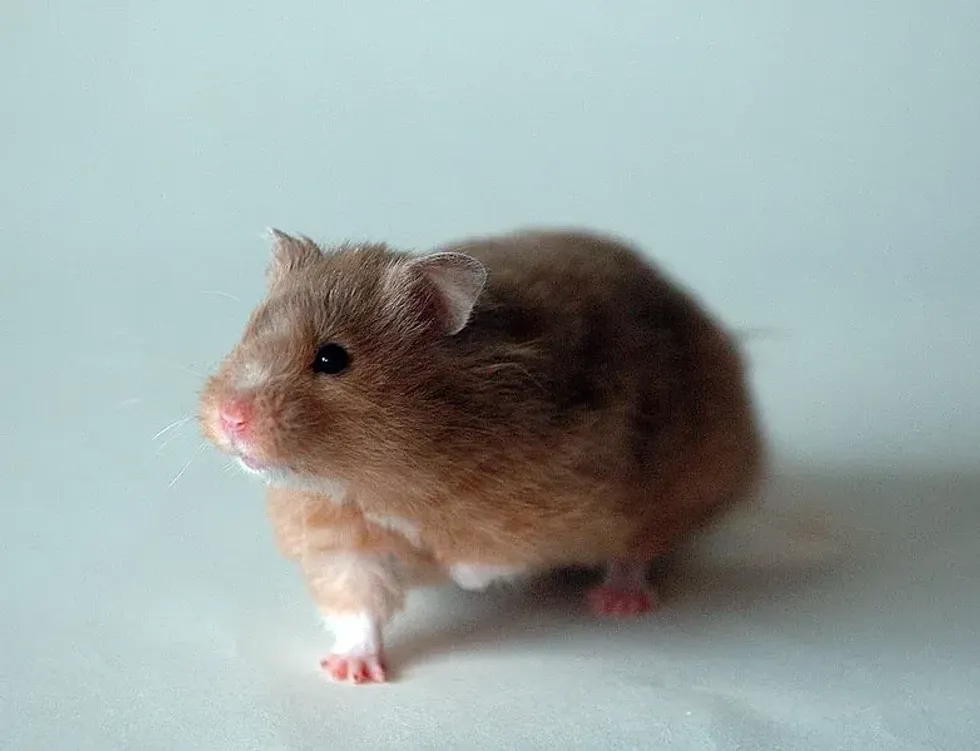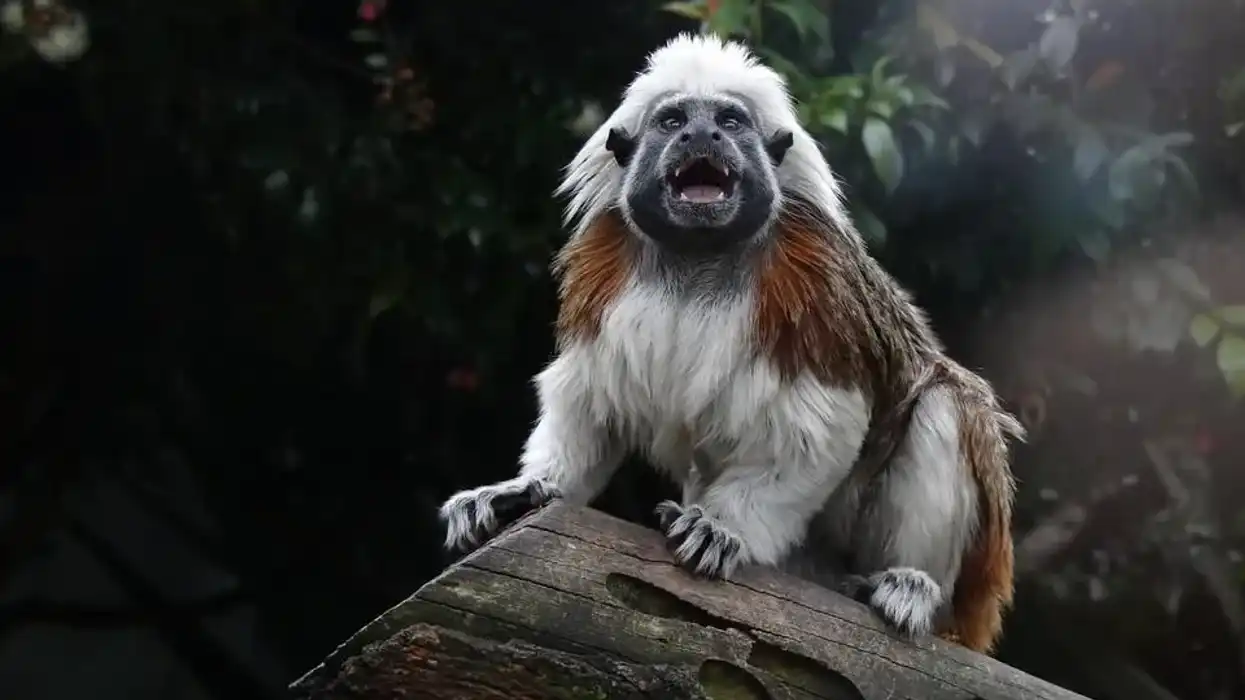The golden hamster (Mesocricetus auratus) is a common species of hamster that is kept as a pet all over the world. Just like any other hamster, it has short, stocky legs, a stout body, short and wide feet, and small, sharp claws. They have a small head, huge internal cheek pouches, and furry ears.
Their cheek pouches extend to behind their shoulders and open inside their lips. Their tail is stubby and can be pink or white. The ones with the long hair are called teddy bears.
The golden hamster’s natural range is restricted to a region around the town of Halab, in northwestern Syria. In this area, the animal inhabits rocky, shrubby, and dry slopes or plains.
In 1930, a small group of these hamsters was transported to Palestine from Syria and their descendants were distributed all over the globe. In 1971, another group was captured in Syria and taken to the US.
Even though golden hamsters are not domesticated, they are tractable. Over the years, they have become popular as pets, as subjects for breeding for biological research, and as animals at zoo exhibits.
You may also check out our fact files on the wood mouse and marsupial mole from Kidadl.
Golden Hamster Interesting Facts
What type of animal is a golden hamster?
A golden hamster or Syrian hamster is a type of rodent living in burrows.
What class of animal does a golden hamster belong to?
A golden hamster or Syrian hamster belongs to the class of mammals.
How many golden hamsters are there in the world?
There isn't enough information to evaluate the exact number of golden hamsters left in the world. However, the IUCN Red List of Threatened species has categorized them as Endangered.
Where does a golden hamster live?
Historically, golden hamsters or Syrian hamsters have been known to inhabit open steppe habitats in burrows that were once the primary characteristics of the Aleppinian plateau and surrounding areas. However, as their range has increased in population, they have shown an interest in agricultural areas. They often burrow near irrigation wells or in legume plots.
What is a golden hamster's habitat?
An open steppe is an ecoregion that is characterized by grass plains. The area doesn’t have trees apart from those near lakes and rivers.
Who does golden hamster live with?
Golden hamsters or Syrian hamsters are solitary in nature. They only meet for breeding.
How long does a golden hamster live?
The average lifespan of a golden hamster or Syrian hamster is one and a half to two years. However, they can live twice as long in captivity. Respiratory issues are common.
How do they reproduce?
Female golden hamsters use olfactory cues in their vaginal secretions for indicating their receptiveness to males. When they are ready to mate, they increase the frequency of their vaginal marking. This behavior is characterized by them pressing their vaginal region against a surface and moving a few inches forward on bedding.
In mature females, ovulation is determined mainly by photoperiod. Ovulation, induced by photoperiods of more than 12.5 hours long, will continue as long as the photoperiod remains.
If the females are exposed to darkness in a laboratory or if the photoperiod is reduced, they will stop ovulating. In five months, they will acclimate to the shorter photoperiod and start to ovulate spontaneously. This photoperiodic cycle in the wild ensures that their young are born when the season is most favorable for survival.
The gestation period for a golden hamster or Syrian hamster is 16 days. The average parturition time is between one and half to two and a half hours. During this time, about eight to 12 young golden hamsters are born after gestation. At birth, the young are altricial which means that they are born with closed eyes.
They open their eyes for the first time at the age of 12-14 days. Weaning occurs when they are 12-21 days old. Young golden hamsters become sexually mature at one month.
What is their conservation status?
The IUCN has listed golden hamsters as an Endangered species because of their localized distribution and small geographic range. The biggest threat to their wild population in burrows is human encroachment on their natural habitat. They are continuously trapped and poisoned.
They are also widely used as research animals and pets. These animals are rare in the wild and found only in northwest Syria. They are, however, common in captivity.
Golden Hamster Fun Facts
What does a golden hamster look like?
A golden hamster or Syrian hamster is a medium-sized hamster that is significantly smaller than a common hamster of western Asia or eastern Europe. However, it is larger than the Roborovski’s desert hamsters of Mongolia and China.
It has a short tail of about 0.5 in (1.5 cm), large ears, relatively small eyes, a blunt rostrum, and a stout body. They have golden-brown fur on their head that fades to white or gray on the ventral surface.
Some hamsters have a dark patch on their forehead and black stripes running on each side of their face from their neck to the cheek. Golden hamsters with long hair on their body are called teddy bears.
How cute are they?
With their adorable eyes, ears, and cheek pouches, no one can deny the cuteness of a golden hamster or Syrian hamster.
How do they communicate?
The most common mode of communication used by this animal is scent marking through scent glands. They also use a wide range of auditory skills.
They create squeaking sounds in different situations that are usually associated with sudden movements. Golden hamsters are also known for teeth chattering which is a sign of aggression. Teeth chattering has been recorded in 39% of observed female to female interactions, 92% of male to male interactions, and 5% in male to female interactions.
Young hamsters produce ultrasonic squeaks that are important for maternal care. Golden hamsters also communicate with conspecifics using visual signals.
How big is a golden hamster?
The average size of a golden hamster or Syrian hamster is 5.1-7 in (13-18 cm), about two times smaller than European hamsters.
How fast can a golden hamster run?
A golden hamster can run at a speed of about 3-6 mph (4.8-9.6 kph) due to its large limbs, similar to a Chinese hamster.
How much does a golden hamster weigh?
The average weight of a golden hamster is 2.9-5.2 oz (85-150 g). They are relatively smaller than black bear hamsters in size.
What are the male and female names of the species?
The male and female names of the golden hamster species are buck and doe, respectively.
What would you call a baby golden hamster?
A baby is called a pup.
What do they eat?
This teddy bear has a diet of fresh vegetables, fruit, hay, and hamster pellet blocks of food. In the wild, their diet includes plants and seeds that they can chew with their teeth. These animals are omnivorous as they also feed on insects like crickets and mealworms.
How active are they?
Golden hamsters (Mesocricetus auratus) don’t participate in social activity.
Would they make a good pet?
Golden hamsters have a docile and inquisitive nature. Their small size and cuteness are the reason why they are so popular as house pets.
However, they have some special requirements that you have to take care of or else their health will deteriorate. Some people think that a golden hamster is a pet for children.
However, the American Society for the Prevention of Cruelty to Animals recommends that a hamster as a pet is only suitable for kids over the age of six and even then, they should be supervised by an adult human. The right bedding, seeds, protein, food, and cages are necessary for their support and treatment as pets.
Hamsters can become infested with fleas, although not as frequently as cats and dogs do. This can be avoided with careful management and treatment though.
Did you know...
After Professor Aharon’s collection in 1930, there were infrequent captures and sightings of golden hamsters in the wild.
Observing the females of this wild population showed that activity patterns are not nocturnal, but crepuscular. This could be to avoid nocturnal predators. There is another theory that suggests that golden hamster mice, who are sensitive to temperature fluctuations, might be crepuscular to avoid the extreme temperatures of daylight and night.
Which type of hamster is the friendliest?
Syrian hamsters have a friendly behavior and form strong bonds with humans in a cage environment. Being the most popular and largest of pet hamsters, they have a long history of availability worldwide. This chunky, slow-moving pets are easy to care for, even by nervous owners.
Chinese hamster's pets also have a friendly behavior, however, they are a little timid. Also, since they move quickly, the owner must be comfortable in handling them outside the cage.
Are golden and Syrian hamsters the same?
Yes, golden and Syrian hamsters are the same.
Here at Kidadl, we have carefully created lots of interesting family-friendly animal facts for everyone to discover! For more relatable content, check out these Catahoula bulldog facts and sei whale facts for kids.
You can even occupy yourself at home by coloring in one of our Golden Hamster coloring pages.









